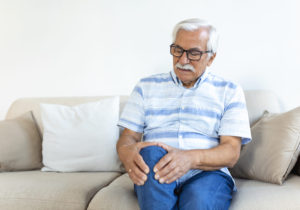Knee pain is a usual complaint of pain in the knee joint. The several reasons for knee pain may include injuries, arthritis, and joint overuse. The knee joint is a complex structure that comprises bones, ligaments, tendons and cartilage. Any of these components can be affected by injury or disease-causing knee pain. Symptoms of knee pain can include stiffness, swelling, difficulty bearing weight, and a popping or cracking sensation.

How Ayurveda describes Knee pain?
In Ayurveda, knee pain (janu sandhishool) occurs due to an imbalance caused by the body’s three doshas: vata, pitta, and kapha. The knee joint is considered a site of vata accumulation, and an excess of vata dosha in the body can lead to dryness and stiffness. Pitta dosha imbalance can also contribute to inflammation and pain in the knee. Kapha dosha imbalance may cause excess weight causing a burden on the knee joint structure and leading to pain.
Reasons for knee pains?
There are several reasons why a person may experience knee pain. Some of the most common causes include:
- Injury: Trauma caused to the knee due to external injuries causing a ligament tear or fractures can cause pain and swelling.
- Osteoarthritis: Osteoarthritis is a degenerative disorder where the cartilage in the knee joint starts perishing, initiating pain and stiffness.
- Rheumatoid arthritis: Rheumatoid arthritis or RA is an autoimmune disorder causing inflammation in the knee joint, leading to pain and stiffness.
- Gout: Medically, gout is a form of arthritis. It occurs due to the build-up of uric acid crystals in the joints causing severe pain and swelling.
- Bursitis: Bursitis is an inflammation of the bursa, a fluid-filled sac, that functions as a cushion, causing pain and swelling in the knee joint.
- Tendinitis: Inflammation of the tendons is called tendinitis. It is a structure that attaches the muscles to the knee bone.
- Overuse of knee joint: Repetitive activities of the knee joint sources wear and tear of the knee joint, leading to pain and inflammation. For example, excessive running or cycling.
- Obesity and overweight: Excess weight puts additional load on the knee joints causing pain and inflammation.
How knee pain manifests in the body?
Knee pain can manifest in several ways that depend on the underlying cause. Some common symptoms of knee pain include:
- Pain: The pain intensity may range from a dull ache to a sharp or stabbing sensation. Pain may get worse when the knee faces extra pressure or load. For example, climbing stairs or standing for long periods.
- Stiffness: The knee joint may feel tight or difficult to move, particularly in the morning or after a long inactivity period.
- Swelling: The knee may be swollen and warm to the touch. Swelling can also occur on the sides of the knee, particularly with knee bursitis.
- Weakness: The knee may feel weak or unstable, making it difficult to bear weight or walk.
- Redness or warmth: The knee may appear red or warm to the touch due to inflammation.
- Cracking or popping sounds: While moving, popping or cracking sounds may be heard from the knee.
- Limited range of motion: The knee may have restricted movement due to pain or stiffness.
- Instability or buckling: The knee may give way or feel like it’s going to buckle.
Ayurveda and panchakarma treatments for knee pain
Ayurveda and Panchakarma are traditional systems of medicine used for centuries in India to treat various health conditions, including knee pain (janu sandhishool). The following are some of the Ayurvedic and Panchakarma treatments that alleviate knee pain:
- Abhyanga: Abhyanga is a traditional form of ayurvedic body massage done with warm medicated oils to lubricate the joints and reduce pain and stiffness. Nidanam Wellness Clinic, a knee pain clinic in Panchkula, has all the panchkarma facilities.
- Snehana: Snehan is a form of internal oleation therapy to pacify the vata and pitta dosha by using medicated oils and ghritams (clarified butter).
- Swedana: This is a form of sweating therapy that reduces inflammation and improves circulation.
- Shirodhara: This is a treatment where warm medicated oil and herbal preparations are poured over the forehead to reduce stress and tension and improve overall well-being.
- Virechana karma: This is a form of purgation therapy used to remove toxins from the body and balance the doshas (particularly pitta dosha).
- Yogasana: Certain yogasanas and pranayama (breathing activities) help improve the strength and flexibility of the knee joint.
- Ayurvedic and herbal remedies: several ayurvedic herbs like ginger, turmeric, ashwagandha, and liquorice root may reduce inflammation and promote healing.
It’s important to note that Ayurvedic and panchkarma treatment should be done under the guidance of a qualified Ayurvedic practitioner, as self-treatment can cause more harm than good. After a complete body analysis of the patient, the practitioner prescribes the treatment suitable to his body type. Dr Jyotiraditya Agarwal is a knee pain doctor in Panchkula. Dr Jyotiraditya treats knee pain conditions by the methods mentioned in Ayurveda and panchkarma.
FAQ's
Why is a pain in the inner side of the knee?
Pain on the inner side of the knee, also known as medial knee pain, can be caused by several factors like medial collateral ligament (MCL) injury, osteoarthritis, meniscus tear, patellofemoral pain syndrome, bursitis, and overuse of the knee joint.
Why my knee hurts when I bend it and straighten it?
If your knee hurts when you bend and straighten it, it could be due to several factors like osteoarthritis, meniscus tear, patellofemoral pain syndrome, patellar tendinitis, baker’s cyst, ACL injury and bursitis.
Dr. Jyotiraditya Agarwal

Contact Us
Testimonials

Rahul Sharma
CIVIL ENGINEER
I am very satisfied with my back pain problem that is almost 100 % resolved by treatment done at Nidanam. My problem was almost 8 years old. I had consulted so many doctors but in vain… then came to know about this clinic and now my back pain is History.


Aditi Bose
DESIGNER
I am extremely happy with my Hair Treatment done by Dr. Bhavana. I was almost on the verge of getting bald. I started my Hair treatment at Nidanam and it took me 6 months to find my scalp full of hairs back. I am Very very happy with the results.


Pulkit Rastogi
CUSTOMER
I lost almost 27 Kg here at Nidanam. They don’t make you starve nor make you exercise hard. With their specialized diet plans along with weigh loss techniques I was able to shed off those Kgs..
